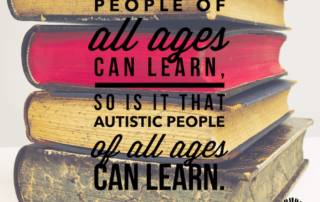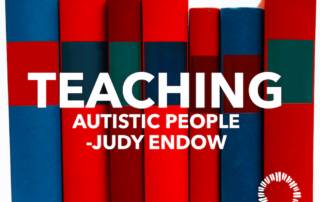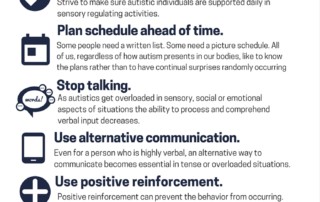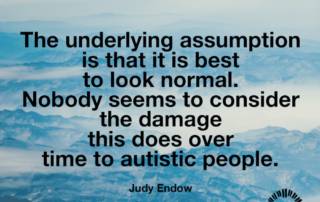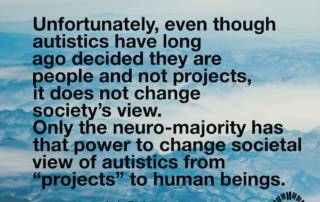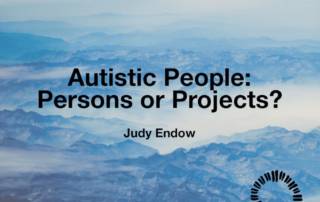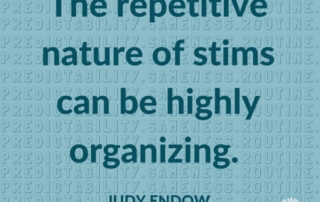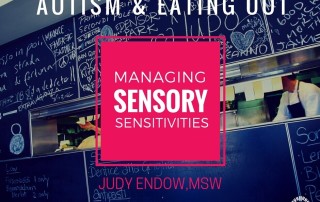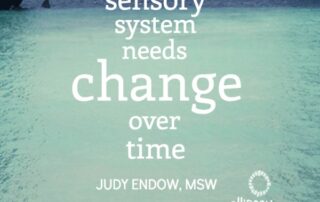Teaching Autistic People
by Judy Endow Autistic People of All Ages Can Learn Just like people of all ages can learn, so is it that autistic people of all ages can learn. It is an utterly sad state of affairs that this even needs to be said, but unfortunately, it needs to be said. Too often I see autistic children being babysat rather than being taught at school. When I ask about academic curriculum being used, I am told, “Oh, he has autism” as if this is an answer to my question. In my work as an autism consultant I am called on
Autism and Consequences
by Judy Endow Autism and Consequences Sometimes a person with authority over another engineers a consequence for certain behaviors as a way to decrease the frequency of unwanted behaviors. One way people learn is from consequences. For example, if you leave your car parked outside with the windows down and it rains, the natural consequence is that your car seats will get wet. Sometimes a person with authority over another engineers a consequence for certain behaviors as a way to decrease the frequency of unwanted behaviors. For example, a mother or a caregiver might decide that if hitting occurs at
Autistic People: Persons or Projects?
Autistic People: Persons or Projects by Judy Endow Autistic people experience the world differently than non-autistic people experience the world. One reasons for this difference is the autistic sensory system is quite different from the neuro-majority, which is considered the norm. In addition, the autistic thinking style has differences from the neuro-majority norm. Autistic Sensory and Thinking Differences The autistic sensory system takes in information from the environment. This information can come in too big, too small, delayed or distorted. Autistic thinking style is often visual, concrete and many have a thinking-in-pictures style of their own. This means processing
The Predictability, Pattern and Routine of Stimming
by Judy Endow The neurology of a person with autism does not automatically organize the world outside their skin. When we are able to organize the happenings in the world we usually do so differently than neuro majority people. As a young child I saw over and over how light from the sun interacted with water particles rising from the ground and with water droplets in the air. This repeated experience became useful over time in that I learned the predictability of this occurrence. I also learned the effects of various factors (such as clouds, rain, air temperature, wind,
Autism and Eating Out
Autistic author and consultant, Judy Endow, shares strategies for managing sensory sensitivities when eating out.
Visual Accommodations and Blessings of My Autism
The visual sensory aspects of the way autism plays out for me most of the time means that I get too much information delivered – things are too big, too bright, too bold – typically too much to endure all day. Practically, this means I need to accommodate my sensory system in a variety of ways. Let’s take but one example from my life where visual overload is a pretty constant problem. Here are some things I have found helpful: Environmental Accommodations for Overhead Lights Most of the time I simply do what I need unless it
Accommodations – They Make All The Difference
Accommodations are important and they work. I should not be making a big deal about it. The ADA is 25 years old. Sadly, getting the accommodations we, disable people need, is often the opposite of simple. If you have been reading my posts, you know that I am very visibly disabled. I am also proud, and I don't try to be someone other than myself. I do require a lot of supports, and once I have them, I can do anything I set up as goals. I have goals, or simply things I want to do, that most people
Autism and A Changing Sensory System
Something about autistic sensory difference that I do not see addressed in the literature is the fact that sensory system needs change over time.
Autism and Sorting Out Sensory Snags
All my life I have been easily overwhelmed by sound and motion. I can hear things nobody else even notices such as the hum of electric devices that are plugged in even when the appliance or device is not in use such as the coffee maker on my kitchen counter. I can hear fluorescent lights hum, the steady grind of ventilation systems in buildings and the crackling from inside my television when it is muted. When I am in the midst of much movement I tend to get dizzy. This is really distracting because I am in busy places when
Fractured Vision: One Autistic Phenomenon
I started painting with acrylics in 2012. I wanted to use that medium to illustrate aspects of my autism. To date I have written several articles and books along with speaking in three countries about aspects of autism. Painting is one more way to explain some of the nuances of autism to those who might be interested. Painting allows me to show perceptions of the world that I see with my eyes as delivered through the neurology of my autism. I match up what I see with the colors and movements of paint on canvas paper. I have not taken classes
Sensory Tool Kit or Purse ?
Notebooks, silly putty, colored pencils, a favorite book.. I did many of these suggestions with all three of my kids when they were little. A mom carries around ever so many things in her purse to entertain kids in public places. However, if the kid has been diagnosed with autism you call all the junk in your purse a sensory tool kit. The difference here is if the kid is not on the spectrum it is a nice diversion and helps keep him better behaved. If the kid is on the spectrum the regulation offered by the stuff in your purse is

